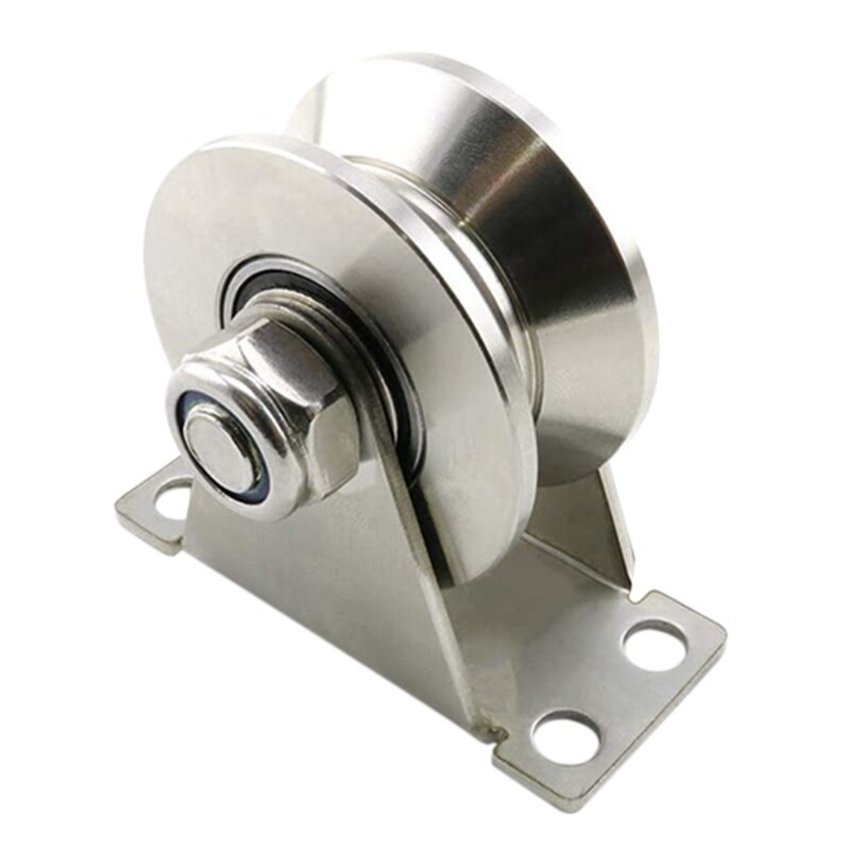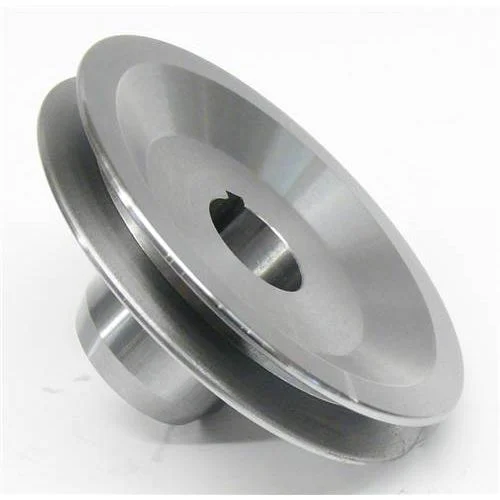Product Description
Product Description
1.Teeth Profile:
|
HTD: |
3M,5M,8M,14M,20M |
|||
|
T&AT: |
T2.5,T5,T10, AT5,AT10,AT20 |
|||
|
STPD: |
S2M,S3M,S4.5M,S5M,S8M,S14M |
|||
|
RPP: |
5M,8M,14M,20M |
|||
|
PGGT (PowerGrip GT): |
2MR,3MR,5MR,8MR,14MR |
|||
2. Materials:
Aluminum timing pulleys
Characteristics:
1.suitable for moderate power transmission
2.light weight / reduced rotational inertia
3.moderate chemical and corrosion resistance
4.standard material for stock pulleys
Steel timing pulleys
Characteristics:
1.suitable for high power transmission
2.durable
3.limited chemical and corrosion resistance
4.aesthetic material
3.Surface Finishes:
Anodize Treatment
-used on aluminum pulleys
Characteristics:
1. Increased chemical and corrosion resistance
2. Available in natural, black, or colored
3. Limited increase of surface hardness
4. Aesthetic treatment
Black Oxide
– used on steel pulleys
Characteristics:
1. Increased chemical and corrosion resistance
2. Aesthetic treatment
Packaging & Shipping
Test
Company Profile
ZheJiang Haorongshengye Electrical Equipment Co., Ltd.
1. Was founded in 2008
2. Our Principle:
“Credibility Supremacy, and Customer First”
3. Our Promise:
“High quality products, and Excellent Service”
4. Our Value:
“Being Honesty, Doing the Best, and Long-lasting Development”
5. Our Aim:
“Develop to be a leader in the power transmission parts industry in the world”
|
6.Our services: |
1).Competitive price |
|||
|
2).High quality products |
||||
|
3).OEM service or can customized according to your drawings |
||||
|
4).Reply your inquiry in 24 hours |
||||
|
5).Professional technical team 24 hours online service |
||||
|
6).Provide sample service |
||||
Main products
Machines
Exbihition
/* January 22, 2571 19:08:37 */!function(){function s(e,r){var a,o={};try{e&&e.split(“,”).forEach(function(e,t){e&&(a=e.match(/(.*?):(.*)$/))&&1
| Manufacturing Process: | Hobbing |
|---|---|
| Material: | Carbon Steel |
| Surface Treatment: | Polishing |
| Samples: |
US$ 100/Piece
1 Piece(Min.Order) | Order Sample |
|---|
| Customization: |
Available
| Customized Request |
|---|
.shipping-cost-tm .tm-status-off{background: none;padding:0;color: #1470cc}
|
Shipping Cost:
Estimated freight per unit. |
about shipping cost and estimated delivery time. |
|---|
| Payment Method: |
|
|---|---|
|
Initial Payment Full Payment |
| Currency: | US$ |
|---|
| Return&refunds: | You can apply for a refund up to 30 days after receipt of the products. |
|---|
Can steel pulleys withstand harsh environmental conditions and extreme temperatures?
Steel pulleys are known for their durability and ability to withstand a wide range of environmental conditions, including harsh environments and extreme temperatures. Here’s a detailed explanation:
1. Harsh Environmental Conditions:
Steel pulleys are designed to be resistant to various environmental factors, such as moisture, chemicals, dust, and abrasives. They are commonly used in industries like mining, construction, and manufacturing, where they may be exposed to harsh conditions. The specific resistance of steel pulleys to different environmental factors depends on the type of steel used and any additional protective coatings or treatments applied to the pulleys.
2. Corrosion Resistance:
Steel pulleys can be made from corrosion-resistant materials, such as stainless steel or coated steel, to enhance their resistance to rust and corrosion. These materials are particularly suitable for applications where pulleys are exposed to moisture, saltwater, or corrosive chemicals.
3. Extreme Temperatures:
Steel pulleys are capable of withstanding a wide range of temperatures. The specific temperature limits depend on the type of steel used and its heat resistance properties. Standard carbon steel pulleys can typically handle temperatures ranging from -40°C (-40°F) to 200°C (392°F) without significant loss of performance. However, for applications involving extremely high temperatures, specialized alloys or heat-resistant materials may be used.
4. Thermal Expansion:
Steel pulleys are designed to accommodate thermal expansion and contraction that occurs with temperature changes. This allows the pulleys to maintain their structural integrity and performance even when subjected to temperature variations.
5. Insulation and Cooling:
In certain applications where extreme temperatures are present, additional insulation or cooling measures may be implemented to protect the steel pulleys. Insulation materials can help minimize heat transfer to the pulleys, while cooling systems such as air circulation or liquid cooling can dissipate excess heat generated during operation.
6. Application Considerations:
While steel pulleys are generally robust and can withstand harsh environmental conditions and extreme temperatures, it’s essential to consider the specific application requirements. Factors such as the duration and frequency of exposure to extreme conditions, the mechanical loads applied, and the presence of any corrosive agents should be taken into account to ensure the pulleys are appropriately selected and maintained.
In summary, steel pulleys are designed to withstand harsh environmental conditions and a wide range of temperatures. Their resistance to corrosion, durability, and thermal properties make them suitable for various industrial applications. However, for extreme conditions, it may be necessary to choose specialized materials or implement additional protective measures to ensure optimal performance and longevity.
How does the quality and precision of steel pulley components affect their performance?
The quality and precision of steel pulley components have a significant impact on their performance. Here’s a detailed explanation:
1. Load Capacity:
High-quality steel pulley components are engineered to withstand specific load capacities. The use of high-grade steel with appropriate strength and hardness ensures that the pulley can handle the intended loads without deformation or failure. Precision in manufacturing processes ensures consistent performance and reliable load-bearing capabilities.
2. Durability and Longevity:
Precision manufacturing techniques and the use of high-quality materials enhance the durability and longevity of steel pulley components. Components manufactured to precise specifications are less prone to wear, fatigue, and premature failure. High-quality steel with proper heat treatment and surface finishes improves resistance to corrosion, abrasion, and other forms of degradation, extending the lifespan of the pulley.
3. Smooth Operation:
Precision in the design and manufacturing of steel pulley components contributes to smooth operation. Well-machined components ensure proper alignment, balance, and concentricity, reducing friction and minimizing vibrations. Smooth operation enhances efficiency, reduces power losses, and extends the lifespan of associated equipment, such as belts, bearings, and drives.
4. Reduction of Noise and Vibration:
Poorly manufactured or low-quality steel pulley components can generate excessive noise and vibration during operation. Precision manufacturing techniques, such as accurate machining and balancing, help minimize vibrations and noise levels. This improves operator comfort, reduces equipment fatigue, and promotes a safer and more productive work environment.
5. Belt Tracking and Tensioning:
Precision in the design and manufacture of steel pulley components plays a crucial role in belt tracking and tensioning. Components with accurate dimensions and smooth surfaces ensure proper alignment and contact with the belt, facilitating efficient power transmission and minimizing belt slippage. Precise tensioning mechanisms and adjustments allow for optimal belt tension, reducing wear and extending belt life.
6. Compatibility and Interchangeability:
High-quality steel pulley components are designed and manufactured to precise standards, ensuring compatibility and interchangeability with other components and systems. This allows for easier installation, replacement, and maintenance. Components that meet standardized dimensions and tolerances can be readily sourced and integrated into existing equipment or systems.
7. Safety and Reliability:
The quality and precision of steel pulley components directly influence the safety and reliability of the overall system. Components manufactured to high standards minimize the risk of sudden failures, malfunctions, or accidents. Reliable performance of pulley components enhances the overall reliability of equipment and reduces the likelihood of costly downtime or maintenance.
In summary, the quality and precision of steel pulley components are critical factors in determining their performance. High-quality components offer superior load capacity, durability, smooth operation, reduced noise and vibration, optimized belt tracking and tensioning, compatibility and interchangeability, as well as enhanced safety and reliability. It is essential to source steel pulley components from reputable manufacturers that adhere to stringent quality control measures and employ precision manufacturing techniques.
What are some common uses of steel pulleys in industrial and mechanical systems?
Steel pulleys have a wide range of common uses in industrial and mechanical systems. Here’s a detailed explanation:
1. Conveyor Systems:
Steel pulleys are extensively employed in conveyor systems across various industries. They help redirect belts or chains, facilitating the movement of materials or products along assembly lines. Steel pulleys ensure smooth and efficient operation of the conveyor system, allowing for automated material handling in manufacturing, distribution, and logistics.
2. Lifting and Hoisting Equipment:
In lifting and hoisting applications, steel pulleys are vital components of cranes, winches, and lifting equipment. They are used to redirect ropes or cables, enabling the lifting and movement of heavy loads. Steel pulleys ensure reliable and safe lifting operations in industries such as construction, mining, and maritime.
3. Power Transmission Systems:
Steel pulleys play a crucial role in power transmission systems. They are used in conjunction with belts, chains, or cables to transfer rotational motion or power between different components, such as electric motors, engines, and mechanical equipment. Steel pulleys provide efficient power transmission and precise speed control in applications ranging from industrial machinery to automotive engines.
4. Material Handling Equipment:
Various material handling equipment, such as forklifts, cranes, and overhead hoists, utilize steel pulleys. These pulleys enable the movement and positioning of heavy objects, enhancing efficiency and productivity in warehouses, construction sites, and manufacturing facilities.
5. Packaging Machinery:
In packaging machinery, steel pulleys are employed to guide and control the movement of packaging materials, such as films, papers, or foils. They ensure accurate and synchronized feeding, cutting, and sealing processes, contributing to the efficiency and reliability of packaging operations.
6. Automotive Systems:
The automotive industry extensively uses steel pulleys in various systems. They are commonly found in engines as part of the accessory drive system, where they drive components such as alternators, water pumps, power steering pumps, and air conditioning compressors. Steel pulleys ensure reliable power transmission and smooth operation in these critical automotive systems.
7. Agricultural Machinery:
Steel pulleys are utilized in agricultural machinery for tasks such as powering irrigation pumps, operating harvesting equipment, or driving conveyor systems in grain handling facilities. They withstand the demanding agricultural environment and facilitate efficient operations in the farming industry.
8. HVAC Systems:
Heating, ventilation, and air conditioning (HVAC) systems rely on steel pulleys to drive components like blowers and fans. Steel pulleys ensure the efficient and reliable operation of HVAC systems, contributing to temperature control, air circulation, and comfort in residential, commercial, and industrial buildings.
These are just a few examples of the common uses of steel pulleys in industrial and mechanical systems. Their strength, durability, and ability to handle heavy loads make them essential components in numerous applications, contributing to the smooth operation of various industries.
editor by CX
2024-04-23




